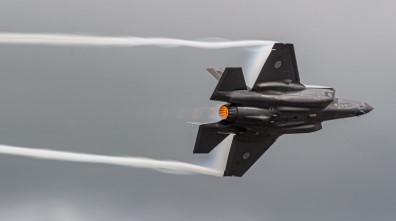China has made a big claim: it says it can track one of the most advanced fighter jets in the world, the F-35 stealth fighter. But the interesting part is, it may not actually be spotting the jet itself. Instead, it’s using a new method that focuses on something the F-35 produces—its heat.
China’s BeiDou System vs. the F-35
The F-35 is a powerful aircraft made to avoid being seen. It has special paint that absorbs radar signals and a body shaped to reflect those signals away. Even its fuel is hidden inside to reduce visibility. Its main goal is to sneak through enemy radar systems without being detected.
However, no aircraft can be made completely invisible. The F-35 still gives off something that’s hard to hide: heat from its engine. When it flies, its engine heats up air to around 3,000 degrees. A lengthy plume of hot air is produced behind it as a result. This heat, known as infrared radiation, can be picked up using special sensors.
According to reports, scientists in China used an unmanned airship that floated about 20 kilometers above the ground. Onboard were high-powered telescopes and detectors made to spot heat. This system, supported by China’s BeiDou satellite network, reportedly saw the heat plume of an F-35 from more than 1,110 miles away. While the F-35’s surface remained cool to confuse regular radar, the hot air behind it was much easier to detect.
Snubbed by F-35 Deal, Saudi Arabia Fractures Global Fighter Jet Alliances with GCAP Pivot
The BeiDou system, which includes dozens of satellites orbiting Earth, helps guide and connect these detection tools. With BeiDou’s global positioning and timing data, researchers are able to pinpoint the source of the heat more accurately and follow the jet’s path across long distances.
This heat detection doesn’t rely on standard radar waves. Instead, it picks up the trail of warmth left by the aircraft as it moves. The kind and direction of an aircraft’s flight can be inferred from this heat signature. That makes even a highly stealthy plane like the F-35 easier to follow—not by seeing the jet, but by spotting its exhaust, with BeiDou helping to track every move.
Decoding the Signals That Stealth Tries to Hide
Stealth aircraft like the F-35 are built to trick enemy radar. They use angles that bounce radar signals away and coatings that absorb them. Normally, this makes it hard for anyone to track where these jets are. But now, China claims to be using a clever twist: using the very confusion caused by stealth jets against them.
JAS-39 Gripen Rejected? U.S. May Force Canada Into F-35 Deal with No Way Out
Here’s how that works. When a radar signal hits a stealth aircraft, it doesn’t bounce back cleanly. Instead, the signal gets scattered or weakened. This used to mean radar systems couldn’t tell what was out there. But Chinese researchers say they can now read the messed-up signals and figure out what caused them.
This is done using the BeiDou satellite system. BeiDou is China’s version of GPS. It has grown into a global satellite network with 45 satellites. It can now provide full Earth coverage. China claims to be able to track the odd patterns created when radar signals strike a stealth aircraft using BeiDou. These patterns, called refraction patterns, are like fingerprints.
Each type of aircraft causes a different pattern. By studying these, scientists can estimate what kind of plane it is and where it might be. This means stealth jets could still be seen, not directly, but by understanding the weird signals they leave behind.
There was another test done using a drone. The drone was flying far from China, but its position was given away when it interacted with signals from a satellite in space. The satellite wasn’t even sending radar—it was just beaming out normal electromagnetic waves. Yet, somehow, the drone’s location was revealed. This shows that even when stealth aircraft try to avoid radar completely, they might still leave traces that can be picked up.
Message to Iran: U.S. B-52s Operate with Israeli F-35Is Amid Rising Tensions in Middle East
A Simpler, Cheaper Way to Spot Stealth Aircraft?
For a long time, countries have tried to build radars strong enough to detect stealth aircraft. These systems are often large, expensive, and easy to spot. What China claims to have now could be very different. It might be simpler, harder to detect, and less costly.
Because BeiDou doesn’t need to blast out radar signals, it can gather information quietly. It watches the effects that stealth aircraft have on the signals already in the air or looks at the heat left behind by flying jets. That could make it tough to know where the tracking system is even located.
This new method may also use other satellite systems, not just BeiDou. That makes it more flexible and harder to disrupt. It doesn’t rely on radar towers or ground-based stations, which are easier to attack or block.
However, the technology isn’t perfect. Reports say the long-distance tracking of an F-35 using heat only works from certain angles. If the jet is facing the sensor directly, it becomes harder to spot. The forward view of the F-35 produces less heat, so it can only be detected from about 350 kilometers away—much shorter than the side or rear views.
In a World-First, U.S. Air Force Turns Two Damaged F-35s into Cutting-Edge ‘Frankenjet’ Combat Plane
While these developments are still being studied and tested, the important part is that stealth aircraft are no longer as invisible as they once seemed. And sometimes, it’s not the aircraft that’s spotted, but the trail it leaves behind.

